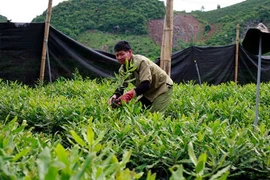A decade seems long enoughto improve farming practices by trial-and-error, however, according to themiddle-aged Thai woman, “even now, we still cannot keep properfinancial accounts”.
During discussions hostedby CARE International last week, stakeholders in the mountain coffeeindustry touched on deeper obstacles facing the industry.
CARE has worked in Vietnamsince 1989, concentrating on supporting rights and sustainable developmentamong vulnerable groups, particularly remote ethnic communities, poor women andgirls and people vulnerable to climate change.
Nguyen Vinh Duc,deputy director of the Son La branch of the Minh Tien Coffee Export JointStock Company, spoke on the drawbacks of small production in the development oflocal coffee.
“Since coffee plantationsin Son La are limited, farmers have not established cooperatives likethose in the Central Highlands provinces of Dak Lak and Lam Dong," hesaid.
"Moreover, differenttechniques used by farmers to process their own beans leads to variation inquality, making it challenging for export companies,” he said.
Duc said that specialisationduring production stages was critical to enhance the quality andincrease the value of local coffee.
Phong is a typicalcoffee farmer in Son La province. According to Lo Minh Hung, vice chairmanof the provincial People’s Committee, there are about 12,000 ha of coffeebelonging to about 400 households in the locality, small compared to the morethan 180,000 ha in Dak Lak province.
At present, the provinceis known for its hydro-electricity industry and has the largest powergenerating dam in the nation. But when all hydro-electric projects have beencompleted, authorities have marked agriculture, particularly fruit and coffee,as the key industry.
The establishment of Son LaTea and Coffee company in 1987 introduced Arabica to the province. This is a strainof coffee more popular in the west than Robusta, the well known Vietnamesecoffee. With more than 30 years of experiences and the advantage of good soil,farmers produce the special beans popular in Germany, Japan and the United States.
Son La authorities aim toraise the coffee-growing area to 14,000 ha by 2020. However, current practiceshave led to soil degradation and a lowering of bean quality.
Moreover, most ethnicfarmers in the province are household units, not collectives. This leads topoor bargaining and limited access to inputs such as fertiliser, seeds andinformation on improving profits.
Therefore, localauthorities aim to develop a sustainable coffee-growing area by tightening thelinks among farmers, processers and traders.
Hung said coffeefarmers should form co-operatives to gain better technology transfer and anexchange of experiences.
Ducsaid that farmers should accelerate good agricultural practices,tighten farm management and protect the environment to acquire internationalcertifications of sustainable farming including UTZ and 4C. "They are astrong foundation for Son La coffee to enhance its quality and accessinternational markets," he said..
“As a trader, our companycreates more favourable conditions for households planting UTZ or 4Ccertified coffee products. Also, we call for the participation of banks inoffering preferential loans and keeping farmers informed about marketprice,” Duc added.
In the past 10 years, Phongand her husband, like several other coffee-growing households in Son La province,have struggled to find markets for their coffee so that they can expand thefarming area.
Now, CARE International incooperation with the Son La and Dien Bien Departments of Agricultureand Rural Development, is implementing a project to support ethnic women in thecoffee value chain. It is referred to as Technologically EnhancedAgricultural Livelihoods, or TEAL.
With about 3 million USD fundedby the Australian Government, it is expected to promote the potential of coffeeproducts in Muong Ang district of Dien Bien province and Mai Son districtof Son La province over the next three years.
“Son La province hasidentified Arabica coffee as one of the core commodities to reduce anderadicate poverty and to lift living standards. The project supports farmersgrowing coffee sustainably and plays an important role in improving theirlives,” said Hung.
At the same time, the roleof women in making economic decision is expected to improve under the CAREprogramme .
By making ethnic women themain stakeholders, CARE is helping support village savings and loanassociations. Simultaneously, a common platform for farmers, traders, consumersand relevant parties will be created to increase productivity and outputand to attract further investment in the local coffee industry.
Empowering women andimproving coffee value are the two core factors under TEAL, an ambitiousproject to promote agricultural products.
“With our experiences inpromoting gender equality via agricultural value chains, we believe in theproject’s ability to improve the living standards of ethnic households,” saidLe Kim Dung, country director of CARE International in Vietnam.-VNA




























